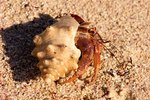
Hermit crabs’ antennae, or feelers, are used to gather information. Sometimes the feelers touch the feelers of another hermit crab. Most often, this action occurs when the crabs are saying hello and learning about one another.
What Are Feelers?
Hermit crabs use their antennae to get around their habitats. They do not have eyes to see, but instead depend on these appendages to navigate their surroundings. Essentially, a crab’s two sets of antennae are working to smell and assess his surroundings. The longer set in front are the ones usually called his "feelers," and are used to navigate surroundings and feel what’s around him. The smaller set are the antennules. They’re used to taste and smell his surroundings.
Tangling Feelers
Sometimes, especially in a crowded tank, two hermit crabs will run into each other. That’s when you’ll notice the antennae of both crabs becoming engaged. Both sets of each one's antennae will touch the other's and flicker wildly. The two crabs may even push one another. This is normal behavior for hermit crabs and should eventually subside without injury to either crab. When two hermit crabs cross paths, they want to smell as well as feel each other, so they engage all four antennae.
Pushing Contests
A feeler fight may look aggressive, but it’s really not a cause for alarm. Even if it progresses into a type of shoving match, it’s still normal behavior. Pushing contests will occur often, especially after or during a feeler fight. This pushing isn’t a sign of aggression, but rather the hermit crab's attempt to move. Hermit crabs are stubborn creatures. They do not go around. They go over or under objects and they’ll push until they have their way.
Identifying Aggression
It’s important to watch for signs of shell-based aggression, because it can result in death. Sometimes a hermit crab will want the shell of his tank mate. He’ll use his feelers to identify the shell. Then he’ll knock his shell against his opponent's, causing her to poke her head out and have a look around. Using his chelipeds, or claws, he’ll attack her. She’ll retreat inside her shell and a battle will ensue. When shell violence occurs, separate the offender. Seclude him with a number of empty shells and perhaps you can interest him in a home that isn’t already occupied. Unfortunately, if this type of aggression occurs when you’re not around, it can result in injury or death.
References
Photo Credits
-
Jupiterimages/Photos.com/Getty Images
Writer Bio
Caryn Anderson combines extensive behind-the-scenes writing experience with her passion for all things food, fashion, garden and travel. Bitten by the travel bug at the age of 15 after a trip to Europe, Anderson fostered her love of style and fashion while living in New York City and earning her degree at New York University.




